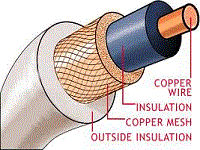Types of Cells
TYPES OF CELLS IN BATTERIES
The development of new and different types of cells in the past decade has been so rapid that it is virtually impossible to have a complete knowledge of all the various types.
Some developments are the silver-zinc, nickel-zinc, nickel-cadmium, silver-cadmium, organic and inorganic lithium, lithium-ion, and mercury cells just to mention a few.
The dry cell is the most popular type of primary cell. It is ideal for simple applications where an inexpensive and non-critical source of electricity is all that is needed.
The dry cell is not actually dry. The electrolyte is not in a liquid state, but is a moist paste. If it should become totally dry, it would no longer be able to transform chemical energy to electrical energy.
Below is a typical cut-away view of a dry cell battery as illustrated in the Encyclopedia Brittanica.

Cut-away view of a general purpose dry cell battery.
These types of cells are also referred to as Leclanche' cells. The internal parts of the cell are located in a cylindrical zinc container.
This zinc container serves as the negative electrode (cathode) of the cell. The container is lined with a nonconducting material, such as blotting paper, to separate the zinc from the paste. A carbon electrode is located in the center, and it serves as the positive terminal (anode) of the cell. The paste is a mixture of several substances such as ammonium chloride, powdered coke, ground carbon, manganese dioxide, zinc chloride, graphite, and water.
This paste, which is packed in the space between the anode and the blotting paper, also serves to hold the anode rigid in the center of the cell. When the paste is packed in the cell, a small space is left at the top for expansion of the electrolytic paste caused by the depolarization action. The cell is then sealed with a cardboard or plastic seal.
Since the zinc container is the cathode, it must be protected with some insulating material to be electrically isolated. Therefore, it is common practice for the manufacturer to enclose the cells in cardboard and metal containers.
These types of cells are basically the same as the simple volt-aic cell (wet cell) described earlier, as far as its internal chemical action is concerned.
The action of the water and the ammonium chloride in the paste, together with the zinc and carbon electrodes, produces the voltage of the cell. Manganese dioxide is added to reduce polarization when current flows and zinc chloride reduces local action when the cell is not being used.
A cell that is not being used (sitting on the shelf) will gradually deteriorate because of slow internal chemical changes (local action). This deterioration is usually very slow if cells are properly stored.
If unused cells are stored in a cool place, their shelf life will be greatly preserved. Therefore, to minimize deterioration, they should be stored in refrigerated spaces.
The blotting paper (paste-coated pulpboard separator) serves two purposes—(1) it keeps the paste from making actual contact with the zinc container and (2) it permits the electrolyte from the paste to filter through to the zinc slowly. The cell is sealed at the top to keep air from entering and drying the electrolyte. Care should be taken to prevent breaking this seal.
There are several other types of cells I will mention here.
Secondary cells are sometimes known as wet cells. There are four basic types of cells called wet cells, the leadacid, nickel-cadmium, silver-zinc, and silver-cadmium.
The lead-acid cell is the most widely used secondary cell. The discharging and charging action presented in electrochemical action describes the lead-acid cell. You should recall that the lead-acid cell has an anode of lead peroxide, a cathode of sponge lead, and the electrolyte is sulfuric acid and water.
The nickel-cadmium cell (NICAD) is far superior to the lead-acid cell. In comparison to lead-acid cells, these cells generally require less maintenance throughout their service life in regard to the adding of electrolyte or water.
The major difference between the nickel-cadmium cell and the lead-acid cell is the material used in the cathode, anode, and electrolyte.
In the nickel-cadmium cell the cathode is cadmium hydroxide, the anode is nickel hydroxide, and the electrolyte is potassium hydroxide and water.
The nickel-cadmium and lead-acid cells have capacities that are comparable at normal discharge rates, but at high discharge rates the nickel-cadmium cell can deliver a larger amount of power. In addition the nickel-cadmium cell can:
1. Be charged in a shorter time,
2. Stay idle longer in any state of charge and keep a full charge when stored for a longer period of time, and
3. Be charged and discharged any number of times without any appreciable damage.
The silver-zinc cell is used extensively to power emergency equipment. This type of cell is relatively expensive and can be charged and discharged fewer times than other types of cells.
When compared to the lead-acid or nickel-cadmium cells, these disadvantages are overweighed by the light weight, small size, and good electrical capacity of the silver-zinc cell.
The silver-zinc cell uses the same electrolyte as the nickel-cadmium cell (potassium hydroxide and water), but the anode and cathode differ from the nickel-cadmium cell. The anode is composed of silver oxide and the cathode is made of zinc.
The silver-cadmium cell is a fairly recent development for use in storage batteries. The silvercadmium cell combines some of the better features of the nickel-cadmium and silver-zinc cells.
It has more than twice the shelf life of the silver-zinc cell and can be recharged many more times. The disadvantages of the silver-cadmium cell are high cost and low voltage production. The electrolyte of the silver-cadmium cell is potassium hydroxide and water as in the nickelcadmium and silver-zinc cells. The anode is silver oxide as in the silver-zinc cell and the cathode is cadmium hydroxide as in the nicad cell.
You may notice that different combinations of materials are used to form the electrolyte, cathode, and anode of different cells. These combinations provide the cells with different qualities for many varied applications.
Become a loyal member to our site. It's free!
Site Search


Translate your page
If English is not your first language you can Translate the text on this page to any one of the languages found in the drop down menu. Select your language from the list for an instant translation.
Looking for something unique for your project? Choose from the drop down menu for quick access to the item you seek.
Related Pages
Become an Electronics Technician
Convert most anything with this utility
Find your wire and cable here!
Sponsored Sites


If you like this site please pay it forward. Donations are welcome.












